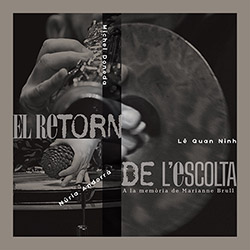
The discipline of creativity is an important woodshed marker when approaching the chain of musical development amongst five busy generations post-Schoenberg vs. Cage. Far beyond Serialism and aleatoric methods, the pluralistic waves of "new" music transcend "who are your musical influences?" to legitimately scrawl under PhD, "Sound Artist, makes assonant field recordings, which are inspired by dissonant splatter techniques of Pollack and Fluxus concrete poetry."
Okay. That fits veteran performers who just are, those who have unlearned, learned, found something new, continue to branch and hone, etc. Artists Lê Quan Ninh and Michel Doneda are established (mythical) enough to be the raised bar, which is why it's really cool (heartwarming, perhaps) to see, onstage in the program notes, a mirror image of Ninh's sideways bass drum, cymbals, and even his signature gigantic pinecones in the hands of newer percussionist, Núria Andorrà.
Whereas Ninh and Doneda typically veer off into extended quiet territories, Andorrà seems to be the eager catalyst that keeps the call-and-response ensemble "active." Based solely in acoustics, the focus of the two percussionists — perched yet flitting like pinned butterfly wings — becomes how long a sound can be sustained — more long tones, booms, tiny things rattling inside larger things, the aforementioned pinecones scraping the drum head. Both players do this through deep vibration, cymbals dragged across the bass drum, sticks and twigs and anything to create friction and release harmonics from said cymbals and otherwise metal and wooden inanimate objects; at times, the duo creates a banshee wash of psychoacoustic extremes, completely confusing your ears as to where we might land. Doneda matches the extrasensory conversation with breathy sax exhales and flutter-tongue blips, falling at times into the seeming role of "lonely loner bird caught in a construction site." He does occasionally offer some atypical glissandi and a few sporadic interruptions, but generally remains a passive support to the otherwise dance; globally and per usual, he shines at subtly stoking and stepping back from the surrounding fires.
The banging and nimble clanging persists for 53 continuous minutes, peaking several moments before with Doneda's overblown, cheek-scrunching sax, fizzing and squealing like a modular synth. Getting there requires a little listener patience considering the intensity, roll call of sounds and contiguous virtuosic non-patterns in this language. That is, the amount of "what's that whistling sound?" does make one long to be present for this wild, room-filling stereo experience where a China crash can be a trumpet and a sopranino sax creates thunder enough to overpower two mounted bass drums and accoutrement.
Comments and Feedback:



More Recent Reviews, Articles, and Interviews @ The Squid's Ear...


|

